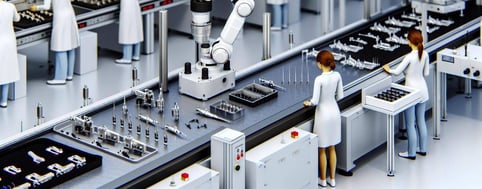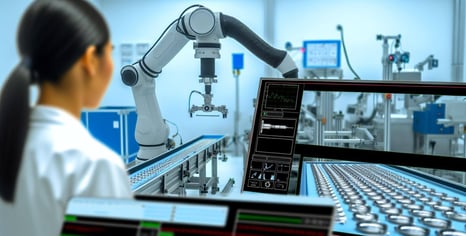Machine Vision for Defect Detection in Medical Manufacturing
In the landscape of Medical Manufacturing, staying ahead of the competition requires embracing cutting-edge technologies. One such innovation that has revolutionized quality control processes is Machine Vision.
This blog explores the pivotal role of Machine Vision in defect detection within manufacturing processes, with a specific focus on its integration with leading ERP, SCM, and MES systems such as SAP, Oracle, Microsoft, Kinaxis, Aveva, and more, including PlanetTogether.
Machine Vision
Machine Vision is a sophisticated technology that empowers machines to interpret and comprehend visual information. In the realm of Medical Manufacturing, where precision and quality are paramount, implementing Machine Vision systems for defect detection has become imperative. These systems utilize cameras and advanced algorithms to analyze images of products during various stages of production, identifying defects with unparalleled accuracy.

The Crucial Need for Defect Detection in Medical Manufacturing
Quality assurance is non-negotiable in the medical industry. Defective products not only compromise patient safety but also tarnish the reputation of the manufacturer. Machine Vision, with its ability to detect minute defects that may go unnoticed by the human eye, plays a pivotal role in upholding the highest standards in medical manufacturing.
Benefits of Machine Vision in Defect Detection
Precision and Accuracy: Machine Vision systems excel in providing precise and accurate defect detection, ensuring that only products meeting the strictest quality standards reach the market.
Increased Production Efficiency: By automating the inspection process, Machine Vision significantly reduces the time required for defect detection, contributing to enhanced production efficiency.
Cost Savings: Early detection of defects prevents the production of faulty products, leading to substantial cost savings associated with recalls, rework, and potential legal ramifications.

Integration with ERP, SCM, and MES Systems
To fully leverage the capabilities of Machine Vision in defect detection, integration with ERP, SCM, and MES systems becomes imperative. Let's look into how the integration with prominent systems like SAP, Oracle, Microsoft, Kinaxis, Aveva, and PlanetTogether enhances the overall manufacturing ecosystem.
SAP Integration
Integrating Machine Vision with SAP streamlines data flow, providing real-time insights into defect detection. This synergy ensures seamless communication between production processes and business operations.
Oracle Collaboration
Machine Vision's defect detection capabilities synergize with Oracle's comprehensive suite of manufacturing solutions, optimizing quality control and contributing to a more agile and responsive manufacturing environment.
Microsoft Dynamics Connectivity
Microsoft Dynamics users benefit from enhanced visibility into manufacturing processes, as Machine Vision seamlessly integrates with the platform, delivering actionable insights for defect detection.
Kinaxis Harmony
The integration of Machine Vision with Kinaxis Harmony augments supply chain visibility, enabling proactive defect detection and mitigation strategies, ultimately contributing to a more resilient supply chain.
Aveva's Unified Manufacturing Platform
The synergy between Machine Vision and Aveva's Unified Manufacturing Platform ensures a holistic approach to defect detection, integrating quality control seamlessly into the manufacturing workflow.
PlanetTogether Optimization
Integration with PlanetTogether optimizes production scheduling based on defect detection data, ensuring that resources are allocated efficiently to rectify and prevent defects in real-time.
Overcoming Challenges and Future Prospects
While the integration of Machine Vision with ERP, SCM, and MES systems brings numerous advantages, challenges such as system compatibility, data security, and initial implementation costs need to be addressed. However, the long-term benefits far outweigh these challenges, positioning manufacturers at the forefront of innovation and quality assurance.
Looking ahead, the future of defect detection in Medical Manufacturing lies in the continued advancement of Machine Vision technologies, including the integration of artificial intelligence and machine learning algorithms, further enhancing the accuracy and efficiency of defect detection processes.
The implementation of Machine Vision for defect detection in Medical Manufacturing is a game-changer. When seamlessly integrated with leading ERP, SCM, and MES systems, including SAP, Oracle, Microsoft, Kinaxis, Aveva, and PlanetTogether, it not only ensures compliance with the highest quality standards but also propels manufacturers into a future where innovation and efficiency go hand in hand.
Embrace Machine Vision, embrace quality, and secure your position at the forefront of the ever-evolving Medical Manufacturing landscape.